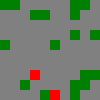This is an Agent Based Model simulator of the Zombie Disease.
Below two results obtained with the simulator. Legend:
- green: healthy human
- yellow: infected human
- red: zombie
- black: killed human or zombie
I've presented the simulator first at Paris.rb Jan 2015.
Install it yourself as:
$ gem install zombie_epidemic
With the default parameters, you just type:
zombie_epidemic
It will store the results as PNG files into the current directory.
zombie_epidemic movie
The space is a discrete 2D bounded map. Each point (x, y) is a square that
could be occupied by an agent or an obstacle.
The time is discrete. Each time step represents enough time for a normal action, such as a step. It is about 0.5 second.
An agent is a person charactherized by the following:
- a position, and
- a health state.
Every time step, an agent can:
- walk,
- attack, or
- stay.
Without any cost, an agent perceive:
- his surrounding (obstacles, position of agents), and
- neighbors' status (zombie or not)
The quality of the perceptions and actions are altered by the health state: a zombie doesn't perceive well, neither it walks well.
The disease model SIZX is implemented as the following state transition machine:
S -------> I -------> Z -------> X
| | ^
| |---------------------|
|--------------------------------|
- other characteristics (e.g. energy level)
- other actions
- other perceptions
- load custom map
- custom strategy
- Fork it ( https://github.com/toch/zombie_epidemic/fork )
- Create your feature branch (
git checkout -b my-new-feature) - Commit your changes (
git commit -am 'Add some feature') - Push to the branch (
git push origin my-new-feature) - Create a new Pull Request

